Fuel System -- Precaution |
- CAUTION:
- Before working on the fuel system, disconnect the cable from the negative (-) battery terminal.
- Do not smoke or be near an open flame when working on the fuel system.
- Keep gasoline away from rubber or leather parts.
| 1.DISCHARGE FUEL SYSTEM PRESSURE |
- CAUTION:
- Do not disconnect any part of the fuel system until you have discharged the fuel system pressure.
- Even after discharging the fuel pressure, place a cloth or equivalent over fittings as you separate them to reduce risk of fuel spray on yourself or in the engine compartment.
Remove the front door scuff plate LH (HILUX_TGN26 RM00000148O01JX_01_0002.html).
Fold back the floor carpet and disconnect the joining connector as shown in the illustration.
- HINT:
- This connector has the lines of the fuel pump and rear speed sensor.
Start the engine. After the engine stops, turn the ignition switch off.
- HINT:
- DTC P0171/25 (system too lean) may be stored.
Crank the engine again and check that the engine does not start.
Remove the fuel tank cap and let the air out of the fuel tank.
Disconnect the cable from the negative (-) battery terminal.
- NOTICE:
- After turning the ignition switch off, waiting time may be required before disconnecting the cable from the battery terminal. Therefore, make sure to read the disconnecting the cable from the battery terminal notice before proceeding with work (HILUX_TGN26 RM000004QR1006X.html).
- When disconnecting the cable, some systems need to be initialized after the cable is reconnected (HILUX_TGN26 RM000004QR300CX.html).
Connect the joining connector.
Install the front door scuff plate LH (HILUX_TGN26 RM00000148N01FX_01_0030.html).
Clear DTCs (HILUX_TGN26 RM000000PDK12LX.html).
| 2.FUEL SYSTEM |
When disconnecting the high fuel pressure line, a large amount of gasoline will spill out. Follow these procedures.
Discharge the fuel system pressure (See above procedure).
Put a container under the connection.
Disconnect the fuel pump tube.
Drain the fuel remaining inside the fuel pump tube.
To protect the disconnected fuel pump tube from damage and contamination, cover it with a plastic bag.
Observe these precautions when removing and installing the injector.
Text in Illustration *1 New O-Ring *2 Fuel Delivery Pipe *a CORRECT *b INCORRECT Never reuse the O-rings.
When placing a new O-ring on the injector, take care not to damage it in any way.
Coat new O-rings with grease or gasoline before installing. Never use engine, gear or brake oil.
Install the injector to the delivery pipe and cylinder head as shown in the illustration.
Text in Illustration *1 Delivery Pipe *2 O-Ring *3 Injector *4 Cylinder Head *5 Insulator - NOTICE:
- Before installing the injector, be sure to apply spindle oil or gasoline to the place where the delivery pipe or cylinder head contacts the O-ring of the injector.
Observe these precautions when disconnecting the fuel tube connector (quick type).
Text in Illustration *1 Fuel Hose Connector Cover Fuel hose connector cover type:
Detach the lock claw by lifting up the cover, as shown in the illustration.Fuel pipe clamp type:
Remove the fuel pipe clamp from the fuel tube connector.Text in Illustration *1 Fuel Pipe Clamp Check for dirt or mud on the pipe and around the connector before disconnection. Clean if necessary.
If the connector and the pipe are stuck, pinch the connector, push and pull the pipe to disconnect the pipe and pull it out.
Text in Illustration *1 Retainer 
Pinch 
Pull - NOTICE:
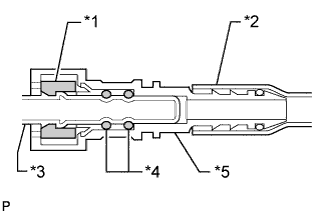
- Check for foreign matter in the pipe and around the connector. Clean if necessary. Foreign matter may damage the O-ring or cause leaks in the seal between the pipe and connector.
- Do not use any tools to separate the pipe and connector.
- Do not forcefully bend or twist the nylon tube.
- Check for foreign matter on the pipe seal surface. Clean if necessary.
- Put the pipe and connector ends in plastic bags to prevent damage and foreign matter contamination.
- If the pipe and connector are stuck together, pinch the connector between your fingers and turn it carefully to disconnect it.
Text in Illustration *1 Retainer *2 Nylon Tube *3 Pipe *4 O-Ring *5 Fuel Tube Connector Check for dirt or mud on the seal surface of the disconnected pipe. Clean if necessary.
To protect the disconnected pipe and connector from damage and contamination, cover it with a plastic bag.
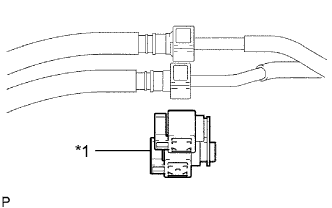

Observe these precautions when connecting the fuel tube connector (quick type).
Check that there is no damage or contamination in the connected part of the pipe.
Align the axis of the connector with the axis of the pipe. Push the pipe into the connector until the connector makes a "click" sound. If the connection is tight, apply a small amount of fresh engine oil on the tip of the pipe.
Text in Illustration 
Push After having finished the connection, try to pull apart the pipe and the connector and confirm that they are securely connected.
Text in Illustration 
Pull Fuel pipe clamp type:
Install the fuel pipe clamp to the connector.Fuel hose connector cover type:
Attach the lock claws to the connector by pushing down on the cover.
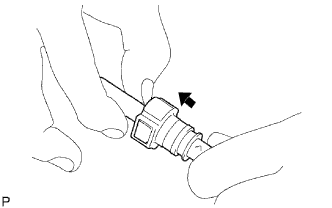
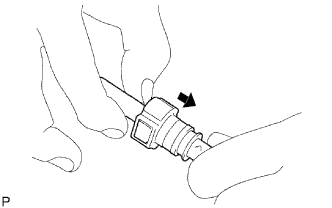
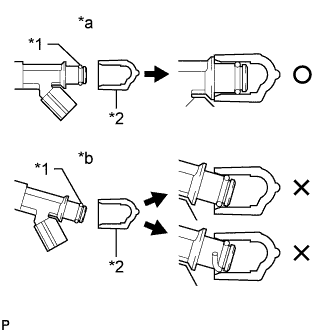 |
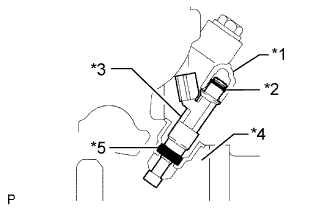 |
 |
| 3.FUEL SUCTION WITH PUMP AND GAUGE TUBE ASSEMBLY |
Do not disconnect the tube shown in the illustration when disassembling the fuel suction tube assembly with pump and gauge. Doing so will cause reassembly of the fuel suction tube assembly with pump and gauge to be impossible as the tube is welded to the plate.
 |
| 4.CHECK FOR FUEL LEAKS |
Check that there are no fuel leaks after performing maintenance anywhere on the fuel system (HILUX_TGN26 RM000000YL704QX_01_0001.html).